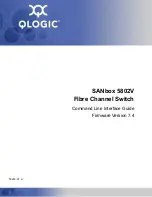
852-1328
Configuration in the WBM
Product manual | Version: 1.2.0
75
Industrial Managed Switch
Term
Description
vals. Each port that ages out RSTP information (from the last BPDU) becomes the Des-
ignated Port for the attached LAN. If it is a Root Port, a new Root Port is selected from
among the switch ports attached to the network.
Hello Time
The Hello Time is the time interval in seconds between configuration messages (BDPU
Bridge Protocol Data Unit) sent from the root switch.
Edge Port
Edge Ports are attached to a LAN that has no other bridges attached. These ports can
transition directly to the Forwarding state. RSTP continues to monitor the port for BPDUs
in case a bridge is connected. RSTP can also be configured to automatically detect
Edge Ports. As soon as the bridge detects a BPDU coming to an Edge Port, the port
loses its status as an Edge Port.
Transmission Limit
The Transmission Limit is used to configure the minimum interval between the transmis-
sion of consecutive RSTP BPDUs. This function can only be enabled in RSTP mode.
The valid range is from 1 to 10 seconds.
Priority
The priority is used in determining the root switch, root port, and designated port. The
switch with the highest priority (lowest numeric value) becomes the RSTP root switch. If
all switches have the same priority, the switch with the lowest MAC address becomes
the root switch.
Enter a value from 0~61440.
The lower the numeric value you assign, the higher the priority for this bridge.
The priority determines the root bridge, which in turn determines the root hello time,
maximum root age, and root forwarding delay.
Convergence Time
Time required to recalculate the spanning tree in the event of a link failure.
BPDU Guard
This setting is configured individual for each port. If the port is enabled in BDU Guard
and receives a BPDU, the port is switched to the Disabled state to prevent a faulty envi-
ronment. The user must then manually enable the port.
BPDU Filter
This function is used to set up a filter for sending or receiving BPDUs on a switch port. If
the port receives BPDUs, the BPDUs are dropped. If both of the BPDU Filter and BPDU
Guard are enabled, the BPDU Filter has the higher priority.
Root Guard
The Root Guard function forces an interface to become a Designated Port to prevent
neighboring switches from becoming a root switch. This function provides a way to spec-
ify the selection of a Root Bridge in a network. It prevents a Designated Port from be-
coming the Root Port. If a port with the Root Guard function receives a superior BPDU,
the port moves to a root-inconsistent state (effectively equal to the Listening state) to
maintain the status of the current Root Bridge. The port can be moved to the Forwarding
state if no superior BPDU received over the period of three Hello Times.
















































